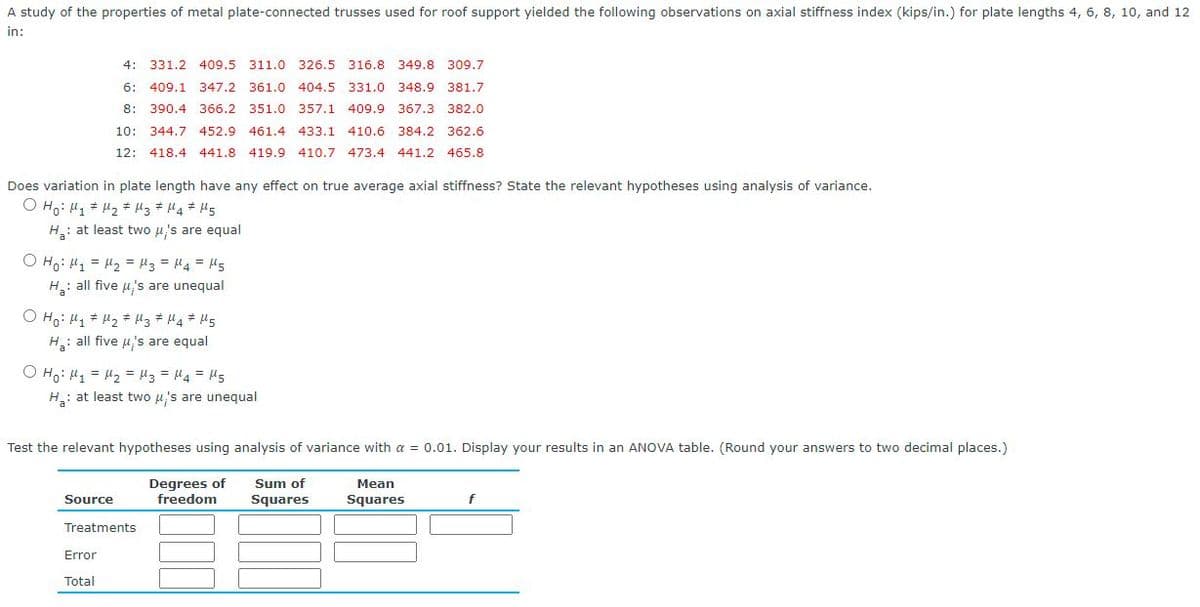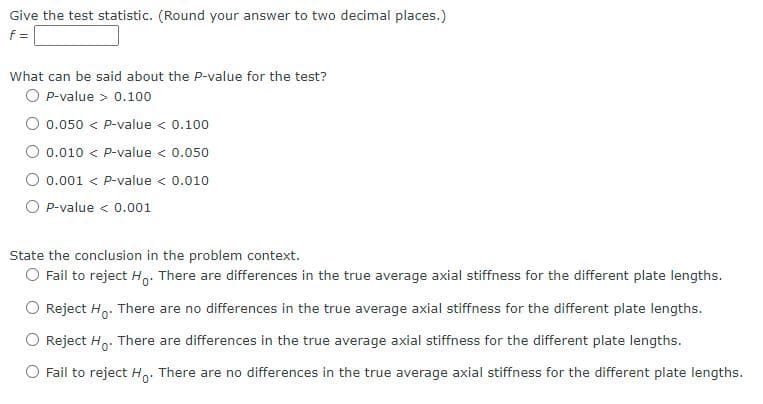A study of the properties of metal plate-connected trusses used for roof support yielded the following observations on axial stiffness index (kips/in.) for plate lengths 4, 6, 8, 10, and 12 in: 4: 331.2 409.5 311.0 326.5 316.8 349.8 309.7 6: 409.1 347.2 361.0 404.5 331.0 348.9 381.7 8: 390.4 366.2 351.0 357.1 409.9 367.3 382.0 10: 344.7 452.9 461.4 433.1 410.6 384.2 362.6 12: 418.4 441.8 419.9 410.7 473.4 441.2 465.8 Does variation in plate length have any effect on true average axial stiffness? State the relevant hypotheses using analysis of variance. H: at least two u's are equal O Ho: H, = H2 = H3 = H4 H5 H: all five 4's are unequal H: all five u's are equal H: at least two u's are unequal Sl = "r = Et = Z = :H O Test the relevant hypotheses using analysis of variance with a = 0.01. Display your results in an ANOVA table. (Round your answers to two decimal places.) Degrees of freedom Sum of Mean Source Squares Squares Treatments Error Total
A study of the properties of metal plate-connected trusses used for roof support yielded the following observations on axial stiffness index (kips/in.) for plate lengths 4, 6, 8, 10, and 12 in: 4: 331.2 409.5 311.0 326.5 316.8 349.8 309.7 6: 409.1 347.2 361.0 404.5 331.0 348.9 381.7 8: 390.4 366.2 351.0 357.1 409.9 367.3 382.0 10: 344.7 452.9 461.4 433.1 410.6 384.2 362.6 12: 418.4 441.8 419.9 410.7 473.4 441.2 465.8 Does variation in plate length have any effect on true average axial stiffness? State the relevant hypotheses using analysis of variance. H: at least two u's are equal O Ho: H, = H2 = H3 = H4 H5 H: all five 4's are unequal H: all five u's are equal H: at least two u's are unequal Sl = "r = Et = Z = :H O Test the relevant hypotheses using analysis of variance with a = 0.01. Display your results in an ANOVA table. (Round your answers to two decimal places.) Degrees of freedom Sum of Mean Source Squares Squares Treatments Error Total
MATLAB: An Introduction with Applications
6th Edition
ISBN:9781119256830
Author:Amos Gilat
Publisher:Amos Gilat
Chapter1: Starting With Matlab
Section: Chapter Questions
Problem 1P
Related questions
Topic Video
Question

Transcribed Image Text:A study of the properties of metal plate-connected trusses used for roof support yielded the following observations on axial stiffness index (kips/in.) for plate lengths 4, 6, 8, 10, and 12
in:
4: 331.2 409.5 311.0 326.5 316.8 349.8 309.7
6: 409.1
347.2 361.0 404.5 331.0 348.9 381.7
8: 390.4 366.2
351.0 357.1 409.9 367.3
382.0
10: 344.7 452.9 461.4 433.1 410.6 384.2 362.6
12: 418.4 441.8 419.9 410.7 473.4 441.2
465.8
Does variation in plate length have any effect on true average axial stiffness? State the relevant hypotheses using analysis of variance.
H: at least two u's are equal
H: all five u's are unequal
SH = trl = Et = = :°H O
O Ho: H1 # H2 # H3 # H4 * H5
H: all five u's are equal
H: at least two u's are unequal
SH = *r = Et = Zyt = ' :°H O
Test the relevant hypotheses using analysis of variance with a = 0.01. Display your results in an ANOVA table. (Round your answers to two decimal places.)
Degrees of
freedom
Sum of
Mean
Source
Squares
Squares
Treatments
Error
Total

Transcribed Image Text:Give the test statistic. (Round your answer to two decimal places.)
f=
What can be said about the P-value for the test?
O P-value > 0.100
0.050 < P-value < 0.100
O 0.010 < P-value < 0.050
0.001 < P-value < 0.010
P-value < 0.001
State the conclusion in the problem context.
O Fail to reject H. There are differences in the true average axial stiffness for the different plate lengths.
Reject H. There are no differences in the true average axial stiffness for the different plate lengths.
Reject Ho. There are differences in the true average axial stiffness for the different plate lengths.
Fail to reject Ho: There are no differences in the true average axial stiffness for the different plate lengths.
Expert Solution
This question has been solved!
Explore an expertly crafted, step-by-step solution for a thorough understanding of key concepts.
This is a popular solution!
Trending now
This is a popular solution!
Step by step
Solved in 5 steps

Knowledge Booster
Learn more about
Need a deep-dive on the concept behind this application? Look no further. Learn more about this topic, statistics and related others by exploring similar questions and additional content below.Recommended textbooks for you

MATLAB: An Introduction with Applications
Statistics
ISBN:
9781119256830
Author:
Amos Gilat
Publisher:
John Wiley & Sons Inc

Probability and Statistics for Engineering and th…
Statistics
ISBN:
9781305251809
Author:
Jay L. Devore
Publisher:
Cengage Learning

Statistics for The Behavioral Sciences (MindTap C…
Statistics
ISBN:
9781305504912
Author:
Frederick J Gravetter, Larry B. Wallnau
Publisher:
Cengage Learning

MATLAB: An Introduction with Applications
Statistics
ISBN:
9781119256830
Author:
Amos Gilat
Publisher:
John Wiley & Sons Inc

Probability and Statistics for Engineering and th…
Statistics
ISBN:
9781305251809
Author:
Jay L. Devore
Publisher:
Cengage Learning

Statistics for The Behavioral Sciences (MindTap C…
Statistics
ISBN:
9781305504912
Author:
Frederick J Gravetter, Larry B. Wallnau
Publisher:
Cengage Learning

Elementary Statistics: Picturing the World (7th E…
Statistics
ISBN:
9780134683416
Author:
Ron Larson, Betsy Farber
Publisher:
PEARSON

The Basic Practice of Statistics
Statistics
ISBN:
9781319042578
Author:
David S. Moore, William I. Notz, Michael A. Fligner
Publisher:
W. H. Freeman

Introduction to the Practice of Statistics
Statistics
ISBN:
9781319013387
Author:
David S. Moore, George P. McCabe, Bruce A. Craig
Publisher:
W. H. Freeman